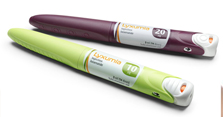
7. Drug updates |
Victoza heart safety results presented

![]() Liraglutide Effect and Action in Diabetes: Evaluation of Cardiovascular Outcome Results—A Long Term Evaluation (LEADER) trial of the glucose-lowering drug liraglutide (Victoza) showing that it significantly reduced the rates of major adverse cardiovascular events in type 2 diabetes patients at elevated cardiovascular risk.
Liraglutide Effect and Action in Diabetes: Evaluation of Cardiovascular Outcome Results—A Long Term Evaluation (LEADER) trial of the glucose-lowering drug liraglutide (Victoza) showing that it significantly reduced the rates of major adverse cardiovascular events in type 2 diabetes patients at elevated cardiovascular risk.
![]() Victoza (liraglutide) injection 1.2 mg or 1.8 mg significantly reduced the risk of the composite primary endpoint of cardiovascular (CV) death, non-fatal myocardial infarction (heart attack) or non-fatal stroke by 13% vs placebo (95% confidence interval [CI]: 0.78; 0.97, p=0.01), when added to standard of care in 9,340 adults with type 2 diabetes at high CV risk. The main results of the LEADER trial were presented at the American Diabetes Association's 76th Scientific Sessions (ADA 2016) and also published in the New England Journal of Medicine.
Victoza (liraglutide) injection 1.2 mg or 1.8 mg significantly reduced the risk of the composite primary endpoint of cardiovascular (CV) death, non-fatal myocardial infarction (heart attack) or non-fatal stroke by 13% vs placebo (95% confidence interval [CI]: 0.78; 0.97, p=0.01), when added to standard of care in 9,340 adults with type 2 diabetes at high CV risk. The main results of the LEADER trial were presented at the American Diabetes Association's 76th Scientific Sessions (ADA 2016) and also published in the New England Journal of Medicine.
![]() There was a significant 22% reduction in cardiovascular death with Victoza treatment vs placebo (95% CI: 0.66; 0.93, p=0.007) and reductions in non-fatal myocardial infarction (HR=0.88, 95% CI: 0.75; 1.03, p=0.11) and non-fatal stroke (HR=0.89, 95% CI: 0.72; 1.11, p=0.30).
There was a significant 22% reduction in cardiovascular death with Victoza treatment vs placebo (95% CI: 0.66; 0.93, p=0.007) and reductions in non-fatal myocardial infarction (HR=0.88, 95% CI: 0.75; 1.03, p=0.11) and non-fatal stroke (HR=0.89, 95% CI: 0.72; 1.11, p=0.30).
EMPA-REG OUTCOME RESULTS ANNOUNCED

![]() Results of the EMPA-REG OUTCOME trial with the sodium-glucose cotransporter-2 (SGLT2) inhibitor empagliflozin (Jardiance) has shown that the drug significantly reduced the incidence of worsening nephropathy by 39% in the population of type 2 diabetes patients who were at high cardiovascular risk. These effects were observed with both doses of empagliflozin employed (10 mg and 25 mg once daily).
Results of the EMPA-REG OUTCOME trial with the sodium-glucose cotransporter-2 (SGLT2) inhibitor empagliflozin (Jardiance) has shown that the drug significantly reduced the incidence of worsening nephropathy by 39% in the population of type 2 diabetes patients who were at high cardiovascular risk. These effects were observed with both doses of empagliflozin employed (10 mg and 25 mg once daily).
![]() In the analysis of microvascular outcomes, incident or worsening nephropathy occurred in 525 of 4124 patients taking empagliflozin and 388 of 2061 in the placebo group (12.7% vs 18.8%; HR, 0.61; P< .001).This renal end point consisted of a combination of progression to macroalbuminuria, a doubling of serum creatinine, the start of renal-replacement therapy, or renal death.
Moreover, the benefit was primarily driven by the reduction in new-onset albuminuria, which occurred in 459 of 4091 patients taking empagliflozin compared with 330 of 2033 patients on placebo (11.2% vs 16.2%; HR, 0.62; P < .001).
Kidney dialysis was also reduced by more than half among those taking empagliflozin, although the absolute numbers affected were small (HR, 0.45; P = .0409).
In the analysis of microvascular outcomes, incident or worsening nephropathy occurred in 525 of 4124 patients taking empagliflozin and 388 of 2061 in the placebo group (12.7% vs 18.8%; HR, 0.61; P< .001).This renal end point consisted of a combination of progression to macroalbuminuria, a doubling of serum creatinine, the start of renal-replacement therapy, or renal death.
Moreover, the benefit was primarily driven by the reduction in new-onset albuminuria, which occurred in 459 of 4091 patients taking empagliflozin compared with 330 of 2033 patients on placebo (11.2% vs 16.2%; HR, 0.62; P < .001).
Kidney dialysis was also reduced by more than half among those taking empagliflozin, although the absolute numbers affected were small (HR, 0.45; P = .0409).
![]() Another SGLT2 inhibitor, canagliflozin (Invokana) is being specifically tested in a diabetic kidney-disease population in the large multicenter randomized Evaluation of the Effects of Canagliflozin on Renal and Cardiovascular Outcomes in Participants With Diabetic Nephropathy (CREDENCE) trial.
Another SGLT2 inhibitor, canagliflozin (Invokana) is being specifically tested in a diabetic kidney-disease population in the large multicenter randomized Evaluation of the Effects of Canagliflozin on Renal and Cardiovascular Outcomes in Participants With Diabetic Nephropathy (CREDENCE) trial.
 Efficacy and Safety of Lixisenatide proven in the GetGoal-L-C Trial
Efficacy and Safety of Lixisenatide proven in the GetGoal-L-C Trial
![]() GetGoal-L-C Trial had patients (n=448) with inadequately controlled T2D were randomized (1:1) to lixisenatide or placebo (PBO) as add-on to basal insulin (BI) ± metformin (Met) after an 8-wk run-in, with BI titration to a target (SMPG of 80-100 mg/dL).
GetGoal-L-C Trial had patients (n=448) with inadequately controlled T2D were randomized (1:1) to lixisenatide or placebo (PBO) as add-on to basal insulin (BI) ± metformin (Met) after an 8-wk run-in, with BI titration to a target (SMPG of 80-100 mg/dL).
![]() Primary endpoint was change in HbA1c from baseline (BL) to wk 24. 2-h PPG, 7-point SMPG, body weight, insulin dose, FPG, and adverse events (AEs) were also assessed. BL demographics were similar across arms (mean age 55 yrs; most patients Asian [86%]; mean BMI 28 kg/m2; mean T2D duration 10 yrs).
Primary endpoint was change in HbA1c from baseline (BL) to wk 24. 2-h PPG, 7-point SMPG, body weight, insulin dose, FPG, and adverse events (AEs) were also assessed. BL demographics were similar across arms (mean age 55 yrs; most patients Asian [86%]; mean BMI 28 kg/m2; mean T2D duration 10 yrs).
![]() Lixisenatide was found to be superior vs. PBO in mean change from BL to wk 24 in HbA1c (Table). The percentage of responders (HbA1c <7% or ≤6.5%) was greater in the lixisenatide arm vs. PBO. Significant improvements were seen for 2-h PPG, 7-point SMPG profile, weight loss, and daily BI dose in the lixisenatide arm vs. PBO.
Lixisenatide was found to be superior vs. PBO in mean change from BL to wk 24 in HbA1c (Table). The percentage of responders (HbA1c <7% or ≤6.5%) was greater in the lixisenatide arm vs. PBO. Significant improvements were seen for 2-h PPG, 7-point SMPG profile, weight loss, and daily BI dose in the lixisenatide arm vs. PBO.
![]() The percentage of treatment-emergent AEs was higher in the lixisenatide arm vs. PBO (64% vs. 41%), mainly due to gastrointestinal events. The incidence of any symptomatic hypoglycemia was low and comparable between arms (lixisenatide 16%; PBO 14%).
The percentage of treatment-emergent AEs was higher in the lixisenatide arm vs. PBO (64% vs. 41%), mainly due to gastrointestinal events. The incidence of any symptomatic hypoglycemia was low and comparable between arms (lixisenatide 16%; PBO 14%).
For enquiries info@jothydev.net.
Please visit: jothydev.net | research.jothydev.com | diabscreenkerala.net | jothydev.com/newsletter
